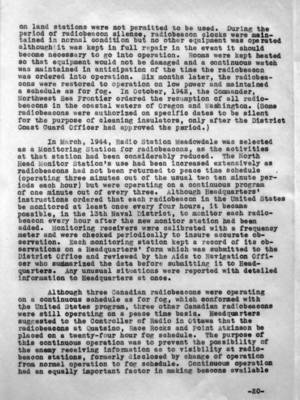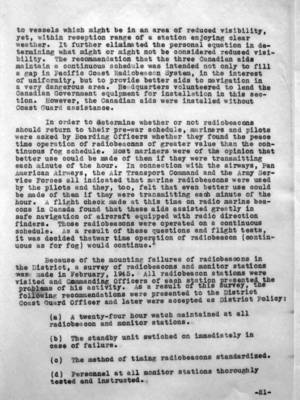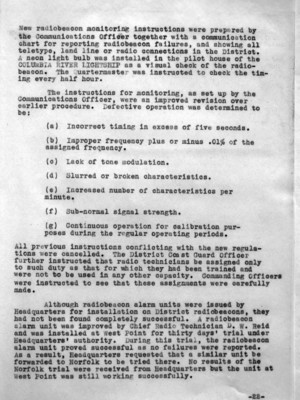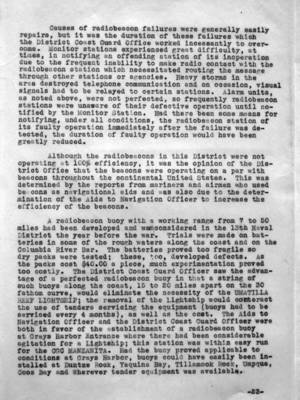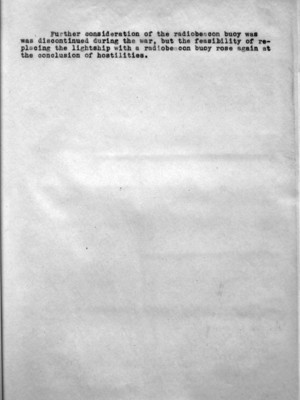Pages That Mention radiobeacon
Coast Guard District narrative histories 1945
39
on land stations were not permitted to be used. During the period of radiobeacon silence, radiobeacon clocks were maintained in normal condition but no other equipment was operated although it was kept in in full repair in the event it should become necessary to go into operation. Rooms were kept heated so that equipment would not be damaged and a continuous watch was maintained in anticipation of the time the radiobeacon was ordered into operation. Six months later, the radiobeacons were restored to operation on low power and maintained a schedule as for fog. In October, 1942, the Commander, Northwest Sea Frontier ordered the resumption of all radiobeacons in the coastal waters of Oregon and Washington. (Some radiobeacons were authorized on specific dates to be silent for the purpose of cleaning insulators, only after the District Coast Guard Officer had approved the period.)
In March, 1944, Radio Station Meadowdale was selected as a Monitoring Station for radiobeacons, as the activities at that station had been considerably reduced. The North Head Monitor Station's use had been increased extensively as radiobeacons had not been returned to peace time schedule (operating three minutes out of the usual two ten minute periods each hour) but were operating on a continuous program of one minute out of every three. Although Headquarters' instructions ordered that each radiobeacon in the United States be monitored at least once every four hours, it became possible, in the 13th Navel District, to monitor each radiobeacon every hour after the new monitor station had been added. Monitoring receivers were calibrated with a frequency meter and were checked periodically to insure accurate observation. Each monitoring station kept a record of its observations on a Headquarters' form which was submitted to the District Office and reviewed by the Aids to Navigation Officer who summarized the data before submitting it to Headquarters. Any unusual situations were reproted with detailed information to Headquarters at once.
Although three Canadian radiobeacons were operating on a continuous schedule as for fog, which conformed with the United States program, three other Canadian radiobeacons were still operating on a peace time basis. Headquarters suggested to the Controller of Radio in Ottawa that the radiobeacons at Quatsino, Race Rocks and Point Atkinson be placed on a twenty-four hour fog schedule. the purpose of this continuous operation was to prevent the possibility of the enemy receiving information as to visibility at radiobeacon stations, formerly disclosed by change of operation from normal operation to fog schedule. Continuous operation had an equally important factor in making beacons available
-20-
40
to vessels which might be in an area of reduced visibility, yet, within reception range of a station enjoying clear weather. It further eliminated the personal equation in determining what might or might not be considered reduced visibility. The recommendation that the three Canadian aids maintain a continuous schedule was intended not only to fill a gap in Pacific Coast Radiobeacon System, in the interest of uniformity, but to provide better aids to navigation in a very dangerous area. Headquarters volunteered to lend the Canadian Government equipment for installation in this section. However, the Canadian aids were installed without Coast Guard assistance.
In order to determine whether of not radiobeacons should return to their pre-war schedule, mariners and pilots were asked by Boarding Officers whether they found the peace time operation of radiobeacons of greater value than the continuous fog schedule. Most mariners were of the opinion that better use could be made of them if they were transmitting each minute of the hour. In connection with the airways, Pan American Airways, the Air Transport Command and the Army Service Forces all indicated that marine radiobeacons were used by the pilots and they, too, felt that even better use could be made of them if they were transmitting each minute of the hour. A flight check made at this time on radio marine beacons in Canada found that these aids assisted greatly in safe navigation of aircraft equipped with radio direction finders. Those radiobeacons were operated on a continuous schedule. As a result of these questions and flight tests, it was decided that war time operation of radiobeacon (continuous as for fog) would continue.
Because of the mounting failures of radiobeacons in the District, a survey of radiobeacons and monitor stations was made in February, 1945. All radiobeacon stations were visited and Commanding Officers of each station presented the problems of his activity. As a result of this survey, the following recommendations were presented to the District Coast Guard Officer and later were accepted as District Policy:
(a) A twenty-four hour watch maintained at all radiobeacon and monitor station.
(b) The standby unit swtiched on immediately in case of failure.
(c) The method of timing radiobeacons standardized.
(d) Personnel at all monitor stations thoroughly tested and instructed.
-21-
41
New radiobeacon monitoring instructions were prepared by the Communications Officer together with a communication chart for reporting radiobeacon failures, and showing all teletype, land line or radio connections in the District. A neon light bulb was installed in the pilot house of the COLUMBIA RIVER LIGHTSHIP as a visual check of the radiobeacon. The Quartermaster was instructed to check the timing every half hour.
The instructions for monitoring, as set up by the Communications Officer, were an improved revision over earlier procedure. Defective operation was determined to be:
(a) Incorrect timing in excess of five seconds.
(b) Improper frequency plus or minus .01% of the assigned frequency.
(c) Lack of tone modulation.
(d) Slurred or broken characteristics.
(e) Increased number of characteristics per minute.
(f) Sub-normal signal strength.
(g) Continuous operation for calibration purposes during the regular operating periods.
All previous instructions conflicting with the new regulations were cancelled. The District Coast Guard Officer further instructed that radio technicians be assigned only to such duty as that for which they had been trained and were not to be used in any other capacity. Commanding Officers were instructed to see that these assignments were carefully made.
Although radiobeacon alarm units were issued by Headquarters for installation on District radiobeacons, they had not been found completely successful. A radiobeacon alarm unit was improved by Chief Radio Technician D. W. Reid and was installed at West Point for thirty days' trial under Headquarters' authority. During this trial, the radiobeacon alarm unit proved successful as no failures were reported. As a result, Headquarters requested that a similar unit be forwarded to Norfolk to be tried there. No results of the Norfolk trial were received from Headquarters but the unit at West Point was still working successfully.
-22-
42
Causes of radiobeacon failures were generally easily repairs, but it was the duration of these failures which the District Coast Guard Office worked incessantly to overcome. Monitor stations experienced great difficulty, at times, in notifying an offending station of its inoperation due to the frequent inability to make radio contact with the radiobeacon station which necessitated routing the message through other stations or agencies. Heavy storms in the area destroyed telephone communication and on occasion, visual signals had to be relayed to certain stations. Alarm units, as noted above, were not perfected, so frequently radiobeacon stations were unaware of their defective operation until notified by the Monitor Station. Had there been some means for notifying, under all conditions, the radiobeacon station of its faulty operation immediately after the failure was detected, the duration of faulty operation would have been greatly reduced.
Although the radiobeacons in this District were not operating at 100% efficiency, it was the opinion of the District Office that the beacons were operating on a par with beacons throughout the continental United States. This was determined by the reports from mariners and airmen who used beacons as navigational aids and was also due to the determination of the Aids to Navigation Officer to increase the efficiency of the beacons.
A radiobeacon buoy with a working range from 7 to 50 miles had been developed and was considered in the 13th Naval District the year before the war. Trials were made on batteries in some of the rough waters along the coast and on the Columbia River Bar. The batteries proved too fragile so dry packs were tested; these, too, developed defects. As the packs cost $40.00 a piece, much experimentation proved too costly. The District Coast Guard Officer saw the advantage of a perfected radiobeacon buoy in that a string of such buoys along the coast, 15 to 20 miles apart on the 30 fathom curve, would eliminate the necessity of the UMATILLA REEF LIGHTSHIP; the removal of the Lightship would counteract the use of tenders servicing the equipment (buoys had to be serviced every 4 months), as well as the cost. The Aids to Navigation Officer and the District Coast Guard Officer were both in favor of the establishment of a radiobeacon buoy at Grays Harbor Entrance where there had been considerable agitation for a Lightship; this station was within easy run for the CGC MANZANITA. Had the buoy proved applicable to conditions at Grays Harbor, buoys could have easily been installed at Duntze Rock, Yaquina Bay, Tillamook Rock, Umpqua, Coos Bay and Wherever tender equipment was available.
-23-
43
Further consideration of the radiobeacon buoy was discontinued during the war, but the feasibility of replacing the lightship with a radiobeacon buoy rose again at the conclusion of hostilities.
